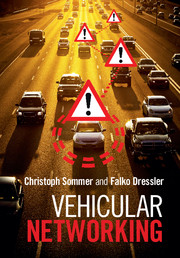Preface
Published online by Cambridge University Press: 18 December 2014
Summary
The intensive use of networked embedded systems is one of the key success factors in the automotive industry, also triggering a massive shortening of innovation cycles. Hundreds of so-called electronic control units (ECUs), connected by kilometers of electrical wiring, operate in today's modern car, enabling a huge variety of new functionalities ranging from safety to comfort applications. All this functionality can be realized only if the ECUs are able to communicate and to cooperate using a real-time enabled communication network in the car.
Today we are at the verge of another leap forward: This in-car network is being extended to not only connect local ECUs but also to connect the whole car to other cars and its environment using inter-vehicle communication (IVC). Relying on existing wireless Internet access using cellular networks of the third (3G) or fourth generation (4G), or novel networking technologies that are being designed specifically for use in the vehicular context such as IEEE WAVE, ETSI ITS-G5, and the IEEE 802.11p protocol, it becomes possible to use spontaneous connections between vehicles to exchange information, promising novel and sometimes futuristic applications.
Using such IVC, safety-relevant information can be exchanged that could not have been obtained using local sensors, enabling a driver to virtually see traffic through large trucks or buildings. This new idea of networked vehicles creates opportunities to not only increase road traffic safety but also improve our driving experience. Traffic jams can be prevented altogether (or at least we would be informed of jams well in advance) – and we might even be able to enable the driver to enjoying fully automated rides in a train-like convoy of cooperating vehicles on the road.
Vehicular networking, the fusion of vehicles' networks to exchange information, is the common basis on which all of these visions build.
Being fascinated with all the opportunities and challenges related to vehicular networking, we have been a part of this research community for close to ten years.
- Type
- Chapter
- Information
- Vehicular Networking , pp. ix - xPublisher: Cambridge University PressPrint publication year: 2014



